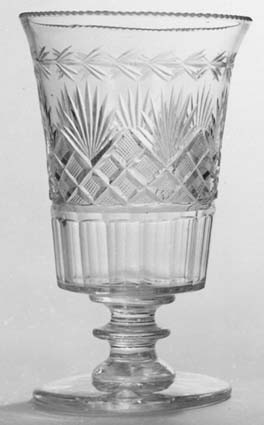
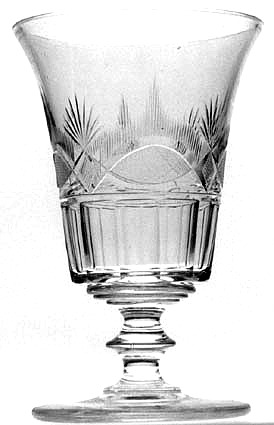
By the 1820s . . . household inventories and shopkeepers' advertisements typically include "glasses", "stands", or "vases" for celery. These were wide-mouth vessels about 6 inches deep, usually raised upon stems to give them prominence on the dining table. Cut glass dramatically emphasized the status of celery and of those who served it, so expensively decorated celery glasses became popular presentation gifts. Those who did not wish to spend $3 to $10 for a pair of cut-glass celeries made do with plain blown, mold-blown, or pressed ones. . . . By 1890 tall celery glasses had been relegated to "a dark corner of the china closet" and replaced with low shallow dishes. -- Arlene Palmer, in GLASS IN EARLY AMERICA (1993, p. 270)
When one considers the popularity of the celery vase -- based on the large number that are found today -- one is tempted to combine the early and middle periods in the history of American cut glass to form "the age of the celery vase". Nevertheless, the following two vases are from the earlier years of the nineteenth century, those that constitute the so-called early period (c1808-c1835). The vase on the left was discovered by the writer at an consignment shop in Barrington, RI in 1984, where it was priced at $10.50. It was his first piece of American cut glass from the early period and even to a fledgling collector it did not seem over-priced! Its partner on the right, and the additional four celery vases that follow, are all typical of this form as it was used during the early and middle periods of American cut glass when celery stalks doubled as table decorations.
CELERY VASES. c1810-c1835. LEFT: English strawberry diamonds and fans. Basal flutes. Husk circuit. In fine, original condition, including its finely notch-cut rim. Solid stem with angular knop, centrally placed. Ground and polished pontil. H = 8" (20.3 cm), rim D = 4.75" (12.1 cm), foot D = 4" (10.2 cm), wt = 1.75 lb (0.8 kg). Sold for $200 in 1984. RIGHT: A vesica pattern with strawberry diamonds, blaze, and fans. Finely notch-cut rim. Basal flutes. Solid stem with angular knop, centrally placed. Ground and polished pontil. Interior of bowl is slightly stained and abraided by wear. Otherwise in fine, original condition. H = 8" (20.3 cm), rim D = 5" (12.7 cm), foot D - 4.25" (10.8 cm), wt = 2 lb (0.9 kg). Sold for $175 in 1989.


The two celery vases that follow are representative of cut-glass styles somewhat later, during the so-called middle period of American cut glass. The vase on the left carries the Ashburton pattern, a pattern that was particularly popular during the middle of the nineteenth century, while the vase on the right is cut in what is sometimes referred to as broken, or off-set, flutes.
CELERY VASES. c1850-c1870. LEFT: The Ashburton pattern: wide flutes in two ranks. Smooth, scalloped rim. Solid, wasted stem, fluted. Ground and polished pontil. Fine, original condition. H = 9.75" (24.8 cm), wt = 3 lb (1.4 kg). Sold for $200 in 1990. RIGHT: Broken flutes. Smooth, scalloped rim. Baluster stem, fluted. Ground and polished pontil. Fine, original condition. H = 9.5" (24.1 cm), wt = 2.5 lb (1.1 kg). Sold for $100 in 1990.
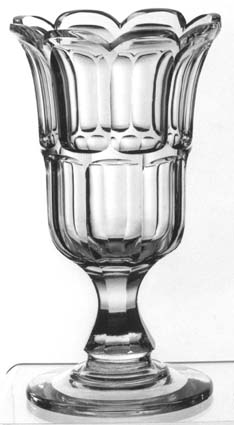
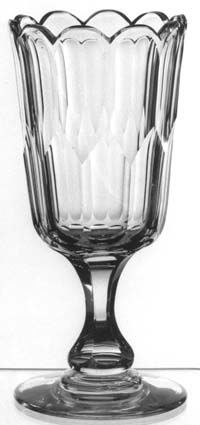
Three-part celery vases are also typical of those made during the latter part of the middle period. The following examples are typical. Note that the drawn stems of the previous examples have been replaced with blown, waisted stems (sometimes called French stems).
CELERY VASES. c1860-c1880. LEFT: Bullseyes (total of 45 in 5 rows of 9 each). The smooth, straight rim is original. Waisted (concave) hollow stem, fluted. 16-pt star on foot. In fine, original condition. H = 8.75" (22.2 cm), rim D = 4" (10.2 cm), foot D = 4.5" (11.4 cm), wt = 2 lb (0.9 kg). Sold for $75 in 1986. RIGHT: Columns of four bullseyes alternating with column of three patches of small, open (table) diamonds (blocks). Smooth, scalloped rim. Waisted (concave) hollow stem, fluted. 16-pt star on foot. In fine, original condition. H = 10.25" (26.0 cm), foot D = 5" (12.7 cm), wt = 3 lb (1.4 kg). Sold for $125 in 1986.
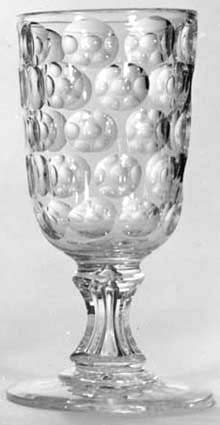

Reference: [Havens, J. M.], 1986: Two items from the middle period, The Hobstar, Vol. 8, No. 8, p. 6 (Jun).
Updated 1 Aug 2007